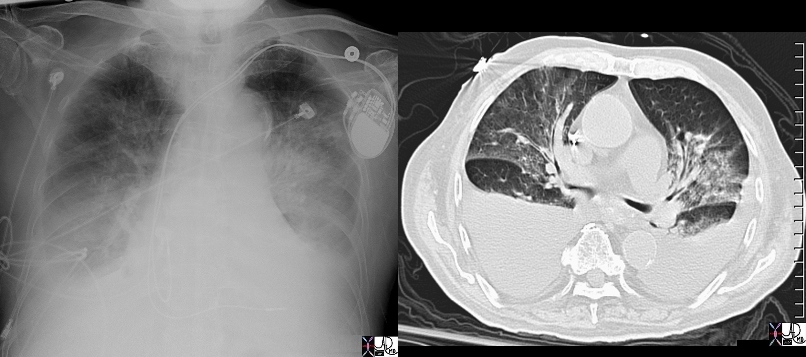The Common Vein copyright 2007
Principles
BASIC X-RAY PHYSICS
A sound understanding of imaging techniques and the physical principles behind them enhances our ability to visualize and appreciate the internal structure and functions of the living body.
Diagnostic X-rays are generated by conversion of the energy acquired by electrons accelerated through an electrical field gradient in the kilovolt (kV) range
X-rays are very high frequency, with short electromagnetic waves
Diagnostically useful wavelengths are between 0.06nm and 0.006nm
An electrically heated filament (cathode) in an X-ray tube generates electrons that accelerate toward a tungsten target (anode) when a high voltage is applied to the tube
As electrons decelerate upon collision with the tungsten target, energy in the form of X-rays (which came at the expense of the kinetic energy of the electrons) is emitted
A beam of X-rays is created and can be aimed at a desired target such as a chest
About 1% of X-rays directed at the body reach the film to expose it
mA vs kVp
mA ? milliamperes
Quantifies current from cathode to anode
Higher mA resulting in more electrons hitting anode per unit time leading to a larger quantity of x-rays
kVp ? kilovolts peak potential
Quantifies voltage difference between cathode and anode
Higher kVp resulting in more ?penetrating? x-rays
INTERACTIONS OF X-RAYS WITH MATTER
No interaction:
X-ray passes completely through tissue to imaging recording device
Complete absorption:
X-ray energy is completely absorbed by the tissue no imaging information results
Partial absorption with scatter:
Scattering results in partial energy transfer to tissue energy and alters the trajectory of X-rays
FACTORS AFFECTING ATTENUATION
Tissue electron density
Dense material (bone, contrast dye) attenuate more X-rays than less dense material (muscle, fat, air)
Tissue thickness
Probability of scatter and interaction increases with tissue thickness (more attenuation)
X-ray energy (kVp)
Increasing kVp means greater beam penetration through tissue (less attenuation)
X-RAY ATTENUATION:BLACK WHITE AND SHADES OF GRAY
BONE
strongly attenuates X-rays (large attenuation coefficient), and presents radio-graphically in white
AIR
Weakly attenuates X-rays (small attenuation coefficient), and therefore presents radio-graphically in black
GRAY
Structural elements that attenuate the beam to a greater extent than air or are less attenuating than bone (i.e. soft tissues) show radiographically in various shades of gray
DOMElement Object
(
[schemaTypeInfo] =>
[tagName] => table
[firstElementChild] => (object value omitted)
[lastElementChild] => (object value omitted)
[childElementCount] => 1
[previousElementSibling] => (object value omitted)
[nextElementSibling] => (object value omitted)
[nodeName] => table
[nodeValue] =>
Batwing Shape of Perihilar Congestion in Acute CHF
49451c01 heart cardiac batwing distribution afx interstitial and alveolar edema air bronchogram shape pacemaker dx acute congestive cardiac failure CHF bilateral effusions CTscan Davidoff MD 49448 49451 49451c01
[nodeType] => 1
[parentNode] => (object value omitted)
[childNodes] => (object value omitted)
[firstChild] => (object value omitted)
[lastChild] => (object value omitted)
[previousSibling] => (object value omitted)
[nextSibling] => (object value omitted)
[attributes] => (object value omitted)
[ownerDocument] => (object value omitted)
[namespaceURI] =>
[prefix] =>
[localName] => table
[baseURI] =>
[textContent] =>
Batwing Shape of Perihilar Congestion in Acute CHF
49451c01 heart cardiac batwing distribution afx interstitial and alveolar edema air bronchogram shape pacemaker dx acute congestive cardiac failure CHF bilateral effusions CTscan Davidoff MD 49448 49451 49451c01
)
DOMElement Object
(
[schemaTypeInfo] =>
[tagName] => td
[firstElementChild] => (object value omitted)
[lastElementChild] => (object value omitted)
[childElementCount] => 1
[previousElementSibling] =>
[nextElementSibling] =>
[nodeName] => td
[nodeValue] => 49451c01 heart cardiac batwing distribution afx interstitial and alveolar edema air bronchogram shape pacemaker dx acute congestive cardiac failure CHF bilateral effusions CTscan Davidoff MD 49448 49451 49451c01
[nodeType] => 1
[parentNode] => (object value omitted)
[childNodes] => (object value omitted)
[firstChild] => (object value omitted)
[lastChild] => (object value omitted)
[previousSibling] => (object value omitted)
[nextSibling] => (object value omitted)
[attributes] => (object value omitted)
[ownerDocument] => (object value omitted)
[namespaceURI] =>
[prefix] =>
[localName] => td
[baseURI] =>
[textContent] => 49451c01 heart cardiac batwing distribution afx interstitial and alveolar edema air bronchogram shape pacemaker dx acute congestive cardiac failure CHF bilateral effusions CTscan Davidoff MD 49448 49451 49451c01
)
DOMElement Object
(
[schemaTypeInfo] =>
[tagName] => td
[firstElementChild] => (object value omitted)
[lastElementChild] => (object value omitted)
[childElementCount] => 3
[previousElementSibling] =>
[nextElementSibling] =>
[nodeName] => td
[nodeValue] =>
Batwing Shape of Perihilar Congestion in Acute CHF
[nodeType] => 1
[parentNode] => (object value omitted)
[childNodes] => (object value omitted)
[firstChild] => (object value omitted)
[lastChild] => (object value omitted)
[previousSibling] => (object value omitted)
[nextSibling] => (object value omitted)
[attributes] => (object value omitted)
[ownerDocument] => (object value omitted)
[namespaceURI] =>
[prefix] =>
[localName] => td
[baseURI] =>
[textContent] =>
Batwing Shape of Perihilar Congestion in Acute CHF
)
https://beta.thecommonvein.net/wp-content/uploads/2023/06/49451c01.jpg https://beta.thecommonvein.net/wp-content/uploads/2023/06/49451.jpg https://beta.thecommonvein.net/wp-content/uploads/2023/06/49448.jpg
http://thecommonvein.net/media/49451c01.jpg https://beta.thecommonvein.net/wp-content/uploads/2023/06/49451c01.jpg



